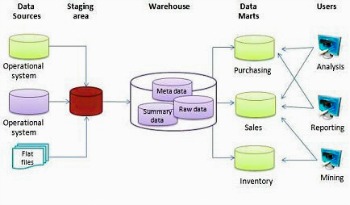Most of us are clueless about most computer lingo. As long as we know how to use a computer or laptop and make our way around the web, then we feel that we are good to go. But as technology progresses and more and more of the processes we use become increasingly complex for our simple minds, it helps to learn about one tech concept at a time so we do not hear crickets chirping in the background the next time we encounter it.
 Data storage is a crucial concept nowadays where conventional means have been shadowed by more advanced ones – just think of the cloud. Things like Cloud backups are critical, especially considering data recovery prices are not going lower. Oh, and there is also data warehousing – an equally important process that makes business all over the world go round and flourish.
Data storage is a crucial concept nowadays where conventional means have been shadowed by more advanced ones – just think of the cloud. Things like Cloud backups are critical, especially considering data recovery prices are not going lower. Oh, and there is also data warehousing – an equally important process that makes business all over the world go round and flourish.
Data warehouse was coined by William H. Inmon in the 1970s. Inmon, known as the Father of Data Warehousing, described a data warehouse as being “a subject-oriented, integrated, time-variant and non-volatile collection of data that supports management’s decision-making process.”
It mainly involves the extraction and storage of modeled or structured data. Data warehousing takes care of important data that a company needs in its conduct of its business. The downside is that it is costly and difficult to make and maintain, which makes it quite unpopular to entrepreneurs, aside from its many limitations.
Traditional data warehouses are limited to structured data. Presently, there is an urgent need from the business world for quick access to new data. We are talking about data coming from outside the organization and unstructured data which makes up approximately 75% of the information in an enterprise. Cambridge Semantics says this is essentially combined with “the decreasing costs of data storage in recent years and the emergence of big data and NoSQL toolsets, in which enterprises began turning to data lakes as an alternative to the challenges of creating yet another data warehouse.”
(Via: https://icrunchdata.com/data-lakes-vs-data-warehousing-how-each-works-digital-technology-boom/)
So, what is gaining traction nowadays? Have you heard about a data lake? What it is and how is it different from a data warehouse?
The bulk of that was from operational systems, some cherry-picked for analysis, but the majority packed away in cold storage where it sat idle. By comparison, Colony Brand’s data warehouse contained just 10 to 15 terabytes of data, which was used for specific business analytics and reporting. The discrepancy between the two got Cretney and his team thinking: What might the data science team uncover if it had access to the data stuck in the SAN?
To make cold storage data available and to push the company in a cloud-first direction, Cretney, a big believer in cloud computing before he came to Colony Brands three years ago, turned to Amazon S3, a data storage service, and Amazon Redshift, a cluster database that will replace the company’s data warehouse. His plan, set in stages with the first to be completed in April, is to build a data lake, making more data more accessible for more analytics.
It provides the same benefits (or even more) of a data warehouse without most of its limitations – to the delight of businesses all over the world (especially the ones with an established online presence and centralized operation).
Data lakes or data hubs — storage repositories and processing systems that can ingest data without compromising the data structure — have become synonymous with modern data architecture and big data management. The upside to the data lake is that it doesn’t require a rigid schema or manipulation of the data to ingest it, making it easy for businesses to collect data of all shapes and sizes. The harder part for CIOs and senior IT leaders is maintaining order once the data arrives. Without an upfront schema imposed on the data, data lake governance, including metadata management, play vital roles in keeping the data lake pristine, according to experts.
(Via: http://searchcio.techtarget.com/feature/Data-lake-governance-A-big-data-do-or-die)
What technology teaches all of us is that if something does not work, we can always innovate and make it better or just get rid of it completely if all else fails. The aim is to always make things better and streamlined as more advanced technology is made available to us as the months and years go by.
It helps to know about all these things even though it mostly applies to technology on a bigger scale – something not all of us are privy of or has access to. Yet, you likely have realized by now that all these things affect our lives one way or the other. Just think of your computer’s hard drive, for instance. You may take it for granted and don’t really know much about it but you get all stressed out once something bad happens to it and your data is now lost (temporarily or for good). But if you have an idea about hard drive data recovery for a specific brand, you know that you may still access your files and you can save your tears for later (in case your data is eventually lost for good).
